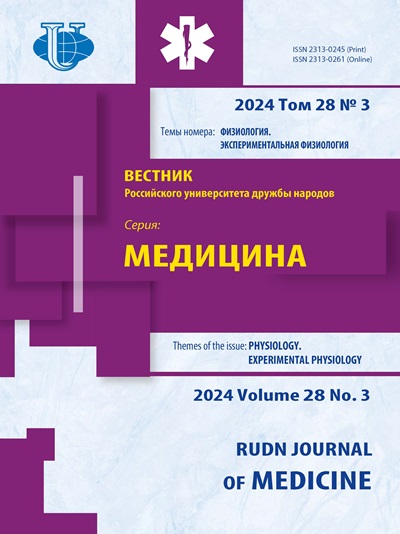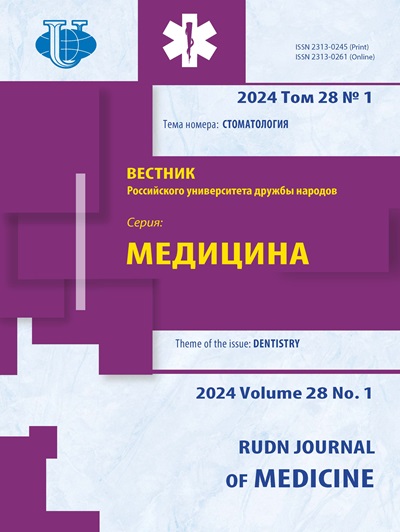Obstetric, somatic and infectious risk factors for vulva sclerotic lichen
- Authors: Osipova L.K.1, Kolesnikova E.V.1, Zharov A.V.1,2, Penzhoyan M.A.1
-
Affiliations:
- Kuban State Medical University
- Regional Clinical Hospital No. 2
- Issue: Vol 28, No 1 (2024): DENTISTRY
- Pages: 86-103
- Section: GINECOLOGY
- URL: https://journals.rudn.ru/medicine/article/view/38300
- DOI: https://doi.org/10.22363/2313-0245-2024-28-1-86-103
- EDN: https://elibrary.ru/UMZRLH
Cite item
Full Text
Abstract
Relevance. Until now, disputes among scientists about its etiology, pathogenesis, nomenclature and risk factors for the development of vulvar lichen sclerosis have not subsided, which actualizes the need for scientific research aimed at solving these problems. The aim of the study - to establish statistically significant clinical and anamnestic risk factors for vulvar lichen sclerosis. Materials and Methods. An electronic database was formed with data from 344 patients with lichen sclerosus of the vulva and 60 women without vulvar diseases aged 20-70 years on hereditary, obstetric-gynecological, somatic and infectious history. A statistical comparative correlation analysis of the obtained data was carried out using the Spearman correlation coefficient (R > 0.15), nonparametric Mann - Whitney U test and Student t test (p < 0.05), Chi-square tests, Phi and Cramer statistics. Results and Discussion. Statistically significant (p < 0.05) risk factors for the development of vulvar lichen sclerosus (R, in descending order) were established: the presence of fibrocystic mastopathy (-0.29); late menarche (15 years and older) (-0.28); onset of menopause (-0.25); recurrent vulvo-vaginal infections (-0.18); recurrent bacterial vaginosis (-0.18); autoimmune thyroiditis (-0.16) and stage II obesity (-0.16). Also, the average number of abortions and births (1.23 and 1.49, respectively) in the group of patients with lichen sclerosis of the vulva is statistically significantly greater (p < 0.05) than the average value (0.27 and 1.13, respectively) in control group. Conclusion. The data obtained on the impact of obesity and autoimmune thyroiditis on the risk of developing vulvar sclerotic lichen are consistent with the results of global studies and confirm the association of the disease with autoimmune and metabolic disorders. Recurrent vulvo-vaginal infections and dysbiotic processes in the vagina can be both a cause and a consequence of vulvar lichen. The relationship between fibrocystic mastopathy and vulvar lichen sclerosus remains debatable and requires further research. Late menarche, the onset of menopause, a large number of abortions and childbirth can also be considered triggers for vulvar lichen sclerosus in patients with a genetic predisposition to the disease.
Keywords
About the authors
Lyudmila K. Osipova
Kuban State Medical University
Email: jokagyno@rambler.ru
ORCID iD: 0009-0003-0257-6732
Krasnodar, Russian Federation
Ekaterina V. Kolesnikova
Kuban State Medical University
Author for correspondence.
Email: jokagyno@rambler.ru
ORCID iD: 0000-0002-6537-2572
SPIN-code: 3707-3561
Krasnodar, Russian Federation
Alexander V. Zharov
Kuban State Medical University; Regional Clinical Hospital No. 2
Email: jokagyno@rambler.ru
ORCID iD: 0000-0002-5460-5959
SPIN-code: 5292-3261
Krasnodar, Russian Federation
Milena A. Penzhoyan
Kuban State Medical University
Email: jokagyno@rambler.ru
ORCID iD: 0000-0003-0371-5629
SPIN-code: 7650-9069
Krasnodar, Russian Federation
References
- Clinical recommendations (treatment protocol) “Lichen sclerotic and atrophic.» 2020. (In Russian) URL: https://www.rodv.ru/klinicheskie-rekomendacii (Access date: 11/15/2021).
- Lewis FM, Tatnall FM, Velangi SS, Bunker CB, Kumar A, Brackenbury F, Mohd Mustapa MF, Exton LS. British Association of Dermatologists guidelines for the management of lichen sclerosus, 2018. Br J Dermatol. 2018;178(4):839-853. doi: 10.1111/bjd.16241
- Van der Meijden WI, Boffa MJ, Ter Harmsel B, Kirtschig G, Lewis F, Moyal-Barracco M, Tiplica GS, Sherrard J. 2021 European guideline for the management of vulval conditions. J. Eur. Acad. Dermatol Venereol. 2022; 36(7): 952-972. doi: 10.1111/jdv.18102
- Chamli A, Souissi A. Lichen Sclerosus. [Updated 2022 Aug 1]. In: StatPearls [Internet]. Treasure Island (FL): StatPearls Publishing; 2023. Available from: https://www.ncbi.nlm.nih.gov/books/NBK538246/
- Simpson RC, Cooper SM, Kirtschig G, Larsen S, Lawton S, McPhee M, Murphy R, Nunns D, Rees S, Tarpey M, Thomas KS; Lichen Sclerosus Priority Setting Partnership Steering Group. Future research priorities for lichen sclerosus - results of a James Lind Alliance Priority Setting Partnership. Br J Dermatol. 2019;180(5):1236-1237. doi: 10.1111/bjd.17447
- Singh N, Ghatage P. Etiology, Clinical Features, and Diagnosis of Vulvar Lichen Sclerosus: A Scoping Review. Obstet Gynecol Int. 2020; 2021:7480754. doi: 10.1155/2020/7480754
- Bieber AK, Steuer AB, Melnick LE, Wong PW, Pomeranz MK. Autoimmune and dermatologic conditions associated with lichen sclerosus. J Am Acad Dermatol. 2021;85(1):228-229. doi: 10.1016/j.jaad.2020.08.011
- Torres A, Zaborek-Łyczba M, Łyczba J, Mertowska P, Mertowski S, Grywalska E. The Importance of Immunological Disorders in the Pathogenesis of Lichen Sclerosus in Pediatric Patients: A Systematic Review. Int J Mol Sci. 2022;23(22):14212. doi: 10.3390/ijms232214212
- Virgili A, Borghi A, Cazzaniga S, Di Landro A, Naldi L, Minghetti S, Verrone A, Stroppiana E, Caproni M, Nasca MR, D’Antuono A, Papini M, Di Lernia V, Corazza M; GLS Italian Study Group. New insights into potential risk factors and associations in genital lichen sclerosus: Data from a multicentre Italian study on 729 consecutive cases. J Eur Acad Dermatol Venereol. 2017;31(4):699-704. doi: 10.1111/jdv.13867
- Porsokhonova DF, Rakhmatullaeva SN, Yakubovich AI, Novoselov VS, Novoselov AV, Kaptil’nyy VA, Sosnova EA. Risk factors of distrophic diseases of vulvae: clinical-epidemiological research. V.F. Snegirev Archives of Obstetrics and Gynecology. 2017; 4(3): 154-158. doi: 10.18821/2313-8726-2017-4-3-154-158. (In Russian).
- Ranum A, Pearson DR. The impact of genital lichen sclerosus and lichen planus on quality of life: a review. Int J Womens Dermatol. 2022;8(3):42. doi: 10.1097/JW9.0000000000000042
- Luu Y, Cheng AL, Reisz C. Elevated body mass index, statin use, and cholecystectomy are associated with vulvar lichen sclerosus: A retrospective, case-control study. J Am Acad Dermatol. 2023;88(6):1376-1378. doi: 10.1016/j.jaad.2023.01.023
- Kolesnikova EV, Zharov AV, Todorov SS, Penzhoyan GA, Mingaleva N.V. Morphological features of various variants of the course of scleroatrophic lichen of the vulva. RUDN Journal of Medicine. 2023;27(1):17-38. doi: 10.22363/2313-0245-2023-27-1-17-38. (In Russian).
- Chan S, Watchorn RE, Muneer A, Bunker CB. Lichen sclerosus following genital piercing. Int J STD AIDS. 2022; 33(5): 522-524. doi: 10.1177/09564624221079068
- Kirby L, Gran S, Orekoya F, Owen C, Simpson R. Is urinary incontinence associated with vulval lichen sclerosus in women? A cross-sectional study. Br J Dermatol. 2021;185(5): 1063-1065. doi: 10.1111/bjd.20583
- Khryanin AA, Sokolovskaya AV, Bocharova VK. Lichen sclerosus: modern ideas and hypotheses. Gynecology. 2022;24(3):212-218. doi: 10.26442/20795696.2022.3.201694. (In Russian).
- Dzhangishieva AK, Uvarova EV, Batyrova ZK. Vulvar lichen sclerosus: a modern view on clinical manifestations, diagnosis and treatment methods (analytical review). Reproductive health of children and adolescents. 2018; 3:34-50. doi: 10.24411/1816-2134-2018-13003. (In Russian).
- Cong Q, Guo X, Zhang S, Wang J, Zhu Y, Wang L, Lu G, Zhang Y, Fu W, Zhou L, Wang S, Liu C, Song J, Yang C, Luo C, Ni T, Sui L, Huang H, Li J. HCV poly U/UC sequence-induced inflammation leads to metabolic disorders in vulvar lichen sclerosis. Life Sci Alliance. 2021; 4(8): e202000906. doi: 10.26508/lsa.202000906
- Semenchak Yu А., Snarskaya E S. Lichen sclerosus. Doctor. 2018; 8: 26-34. doi https://doi.org/10.29296/25877305-2018-08-07. (In Russian).
- Bing-Bo Y, Hui Z, Xiao-Yu Z, Jian-Wen L, Jiang H, Chen S, Wen-Hao X, Gao-Xing Z, Jun T. Mitochondrial dysfunction-mediated decline in angiogenic capacity of endothelial progenitor cells is associated with capillary rarefaction in patients with hypertension via downregulation of CXCR4/JAK2/SIRT5 signaling. E Bio Medicine. 2019; 42: 64-75. doi: 10.1016/j.ebiom.2019.03.031
- Orszulak D, Dulska A, Niziński K, Skowronek K, Bodziony J, Stojko R, Drosdzol-Cop A. Pediatric Vulvar Lichen Sclerosus-A Review of the Literature. Int J Environ Res Public Health. 2021;18(13):7153. doi: 10.3390/ijerph18137153
- Kirtschig G. Lichen Sclerosus-Presentation, Diagnosis and Management. Dtsch Arztebl Int. 2016; 113 (19): 337-343. doi: 10.3238/arztebl.2016.0337
- Nemer KM, Anadkat MJ. Postirradiation Lichen Sclerosus et Atrophicus. JAMA Dermatol. 2017;153(10):1067-1069. doi: 10.1001/jamadermatol.2017.0823
- Mühl S, Ehrchen J, Metze D. Blistering and Skin Fragility Due to Imatinib Therapy: Loss of Laminin and Collagen IV as a Possible Cause of Cutaneous Basement Membrane Instability. Am J Dermatopathol. 2018;40(5):371-374. doi: 10.1097/DAD.0000000000001063
- Seyed Jafari SM, Feldmeyer L, Hunger RE. Development of Extragenital Lichen Sclerosus in Malignant Melanoma Patients Treated With Ipilimumab in Combination With Nivolumab. Front Oncol. 2020;10:573527. doi: 10.3389/fonc.2020.573527
- Miraglia E, Soda G, Giustini S. Genital lichen sclerosus after nivolumab. Dermatol Online J. 2020; 26:13030. doi: 10.5070/D32611047516
- Alharbi A, Khobrani A, Noor A, Alghamdi W, Alotaibi A, Alnuhait M, Haseeb A. Risk of Lichen Sclerosus and Lichen Planus in Patients Receiving Immune Checkpoint Inhibitors. Int J Environ Res Public Health. 2022;20(1):580. doi: 10.3390/ijerph20010580
- Stachs A, Stubert J, Reimer T, Hartmann S. Benign Breast Disease in Women. Dtsch Arztebl Int. 2019;116(33-34):565-574. doi: 10.3238/arztebl.2019.0565
- Malherbe K, Khan M, Fatima S. Fibrocystic Breast Disease. Text: electronic: StatPearls [Internet]. 2023. URL: https://www.ncbi.nlm.nih.gov/books/NBK551609/ (Date of access: 06/05/2023)
- Moreno-Vílchez C, Llobera-Ris C, Torrecilla-Vall-Llossera C, Notario J, Figueras-Nart I. Lichen sclerosus and its association with cancer: a retrospective cohort study. Int J Dermatol. 2023;62(2): 84-85. doi: 10.1111/ijd.16218
- Shim TN, Harwood CA, Marsh SG, Gotch FM, Quint W, de Koning MN, Francis N, Jameson C, Freeman A, Minhas S, Dinneen M, Muneer A, Bunker CB. Immunogenetics and human papillomavirus (HPV) in male genital lichen sclerosus (MGLSc). Int J STD AIDS. 2020;31(14):1334-1339. doi: 10.1177/0956462420949395
- De Luca DA, Papara C, Vorobyev A, Staiger H, Bieber K, Thaçi D, Ludwig RJ. Lichen sclerosus: The 2023 update. Front Med (Lausanne). 2023;10:1106318. doi: 10.3389/fmed.2023.1106318
- Fan R, Leasure AC, Maisha FI, Cohen JM, Little AJ. Thyroid disorders associated with lichen sclerosus: a case-control study in the all of us research program. Br J Dermatol. 2022; 187:797-799. doi: 10.1111/bjd.21702
- Tran DA, Tan X, Macri CJ, Goldstein AT, Fu SW. Lichen Sclerosus: An Autoimmunopathogenic and Genomic Enigma with Emerging Genetic and Immune Targets. Int. J. Biol. Sci. 2019;15:1429-1439. doi: 10.7150/ijbs.34613
- Borisova AV, Klimova OI, Valentinova NN. Scleroatrophic lichen of the vulva: modern approaches to diagnosis and treatment. Obstetrics and gynecology. News. Opinions. Education. 2023;11(S): 109-114. doi: 10.33029/2303-9698-2023-11-suppL-109-114. (In Russian).
Supplementary files
























